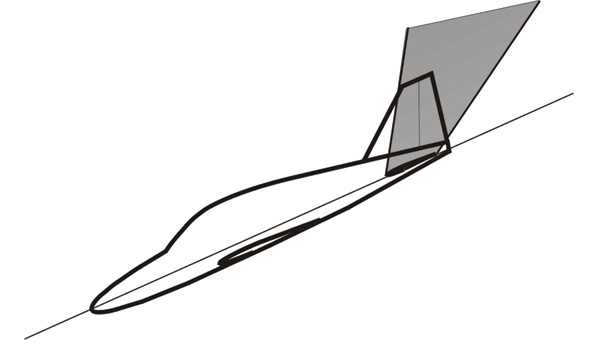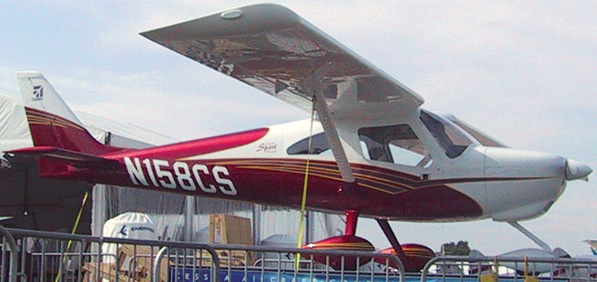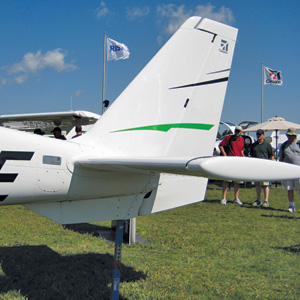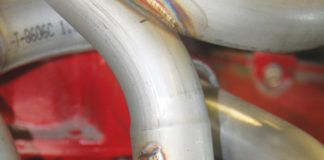In the early days of powered flight, many plane crashes were preceded by what witnesses described as a “spiral dive.” The airplane would quite abruptly put its nose down and follow a corkscrewing path to the ground. Today, of course we understand that the so-called “spiral dive” is really a stall/spin sequence. Pilots feared the spiral dive because they didn’t know what caused it, much less how to correct it, and so it was often fatal.
The first successful recovery from an inadvertent spin is widely attributed to English Lieutenant Wilfred Parke, who got into one in an Avro cabin biplane (one of the first airplanes with a fully enclosed cockpit) in 1912. For several years the British aviation community referred to a spin as a “Parke’s Dive.” Parke reported that he recovered by opposing the rotation of the airplane with the rudder. But what saved him is that, through luck or insight, he chose to concern himself primarily with the rotation of the airplane rather than the nose-down diving attitude.
By the early 1920s, the cause of spins was well understood, and several standard spin recovery techniques had been published. In 1936 NACA published Technical Note 555, which described the “basic spin-recovery procedure” that is still taught today and can be found in the pilot’s manuals of many light airplanes. The classical spin recovery technique for single piston-engine, tractor airplanes from NACA TN 555 (1936) is:
- Briskly move the rudder to a position full against the spin.
- After the lapse of an appreciable time, say after at least one-half additional turn has been made, briskly move the elevator to approximately the full-down position.
- Hold these positions of the controls until recovery is effected.
Basically, for typical light airplanes, the single most important control input is full rudder against the direction of rotation.
The majority of airplanes are never spun on purpose. At first look it would seem that for these airplanes spin recovery characteristics would be unimportant. But an airplane can go into a spin when it is inadvertently stalled during a maneuver-for example, the turn from the base leg of the pattern to final approach. For the airplane to be flown safely, the pilot must have sufficient control power available to stop the spin and recover to level flight.
Until the mid-1970s, the majority of spin research done by NACA and other groups was aimed toward understanding what facets of the configuration affected the ability of the airplane to recover from a developed spin.
In a spin, the airplane is subjected to both aerodynamic and inertial forces. A developed spin is a dynamically stable situation; the aerodynamic forces developed on the wings drive the spin. The rotation is opposed by the yaw damping of the tail and fuselage, leading to a dynamic equilibrium where the rotation rate is close to constant. The inertial and aerodynamic forces are in balance, offsetting each other. If nothing is changed, the spin will continue indefinitely (or until ground impact). To recover from the spin, the stable balance of forces must be broken.
Angle of attack during the spin is well above the initial stall angle of attack. For most light airplane configurations it is somewhere between 30 and 60. At least one wing of the airplane is stalled or partially stalled. The asymmetry of forces between the more-stalled wing and the less-stalled wing provides the pro-spin moments that drive the autorotation of the airplane. The airplane descends nearly vertically, while rotating in a coupled rolling and yawing motion about the flight path. To break the spin, the pilot must re-establish symmetric lift and drag on the wings. The goal is to un-stall both wings and stop the rotation on the airplane.
For the single-engine tractor configuration typical of most light planes, the key to successful spin recovery is stopping the rotation of the spin with anti-spin rudder. After the rotation has been slowed or stopped, down elevator is used to reduce angle of attack and establish unstalled flight. Because the ability of the rudder to generate anti-spin yawing moment is so critical to spin recovery, much attention has been given over the years to the proper design of tail surfaces for spin recovery.

Rudder Power and Tail Design
When the rudder is deflected against the direction of the spin, it produces a yawing moment that opposes the rotation of the airplane. In order to break the spin, this yawing moment must overpower the pro-spin moment being generated by the wing. This means that the airplane’s rudder must be large enough to generate the required moment. The rudder must also have enough clean airflow over it to be effective.
The angle of attack in a spin is much higher than it is in normal flight. The high angle of attack, combined with the presence of large amounts of separated flow can dramatically change the airflow over the tail of the airplane. The flow over the top of the horizontal tail is separated, and there is a separated wake that trails back and up from the tail. Unfortunately, a large portion of the fin and rudder is often immersed in this low-energy separated flow from the horizontal tail. The area in the separated wake is ineffective, and does not contribute much yaw damping or rudder power to aid in spin recovery. The same is true for the fuselage side area above the horizontal tail.
If too much of the rudder is buried in low-energy separated flow, it will not be able to generate enough yawing moment to stop the rotation of a spin. A method of estimating how much of the fin and rudder is blanked by the tailplane wake is shown in Figure 1. On a side view of the airplane, draw a line from the leading edge of the tailplane upward at an angle of 60 above horizontal. From the trailing edge of the tailplane, draw another line upwards at an angle of 30. The airflow in the area between these two lines is likely to be separated in a developed spin. Any fin or rudder area between the two lines will be blanked by the tailplane and will be ineffective.
For acceptable spin recovery characteristics at least a third of the rudder should be outside the separated wake. This is not a guarantee of good spin recovery, but if less than a third of the rudder is clear of the wake, then problems are likely. Because of this, the relative position of the tailplane, fin and rudder are important.
If the rudder ends on top of the fuselage, then the leading edge of the horizontal tail should be aft of the leading edge of the fin. The upper portion of the fin and rudder will then be out of the wake of the horizontal tail. Sweeping the vertical fin aft in such a situation can be highly detrimental, as it moves the upper portion of the fin and rudder aft into the tailplane wake. If the horizontal tail is mounted low and too far forward, it is possible to end up with the entire fin and rudder immersed in the tailplane wake if the tail is aft-swept. An airplane with such a tail design is likely to have spin recovery problems.
A configuration with a rudder that ends on top of the fuselage is less favorable for spin recovery than one with a rudder that extends all the way to the fuselage bottom. Even if the rudder is clear of the tailplane wake, the fuselage may still have a detrimental effect on the airflow over the fin and rudder at high angles of attack. Despite this, there are quite a few airplanes with rudders that end on top of the fuselage, and have good spin recovery characteristics.

A T-tail has good yaw damping and rudder power in an upright spin because the tailplane wake does not impinge on the fin and rudder. In an inverted spin, the opposite is true. Unfortunately, the non-linear pitch behavior that some T-tail airplanes exhibit makes them more prone to enter a spin in the first place. The pitch forces lighten up as angle of attack is increased, and it is relatively easy to get into an inadvertent stall.

If the rudder is carried down to the bottom of the fuselage, then the tailplane should be well forward and/or relatively high on the fuselage. This allows the bottom portion of the rudder to operate in clean air. It has the additional advantage of allowing the lower aft fuselage to produce yaw damping that slows the spin rate.
An example of how much small changes in tail configuration can affect spin recovery is the evolution of the tail of the Cessna Skycatcher. The original tail configuration, shown in Figure 2, had no fin area below the horizontal tail, and the highly swept-back fin was almost entirely in the “dead zone” above the horizontal tail in a spin. Cessna engineers, to their credit, chose to test the airplane to much higher spin recovery standards than the LSA rules require, including recovery from fully developed spins. An early prototype with the same tail configuration as the POC airplane shown in the photo was lost when it failed to recover from a developed spin. The pilot bailed out successfully and was uninjured.
Figure 3 shows the tail configuration of the definitive production Skycatcher. The rudder now extends below the horizontal tail, and some ventral fin area has been added. The additional high angle of attack yaw damping and rudder control power provided by these changes give the airplane satisfactory spin recovery capability.
For a detailed summary of NACA research on tail design and spin recovery see NACA-TN-1045: “Tail Design Requirements for Satisfactory Spin Recovery” by Jacob H. Neihouse, Jacob H. Lichtenstein and Philip W. Pepoon.












